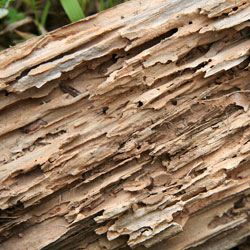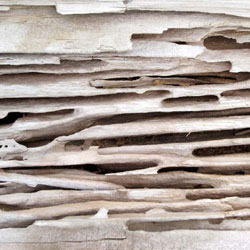What Type Of Damage Does My Wood Have?
Identifying The Source Of Damage To The Wood In Your Crawl Space?

Some mold damage is cosmetic, where other mold growths can severely compromise the strength of the wood.
Likewise, the difference between termite and carpenter ant damage is enormous, with termite damage being far more severe.
Identifying the source of wood damage in your home can give you significant insight on the nature and severity of damage you're facing.
When structural wood is significantly damaged, it becomes unable to bear the weight of your home. As this occurs, the floors above may become uneven, doors may stick or jam, and cracks may form in drywall.
Common Types Of Wood Damage
- Structurally Damaging Mold & Rot
- Cosmetic Mold Damage
- Dry Rot (Brown Rot) Damage
- Termite Damage
- Carpenter Ant Damage
- Powderpost Beetle Damage
Repairing damage to your structural wood early on can prevent symptoms of structural damage from occurring or becoming more severe.
At Basement Systems, our crawl space experts can help you repair your crawl space and reinforce your damaged or weakened structure. We also offer a warrantied crawl space encapsulation system that will help to keep your space drier and healthier.
It costs you nothing to meet with one of our experts! To schedule a free crawl space repair estimate with one of our specialist in Canada or the United States, contact us by phone or e-mail today!
What Kind Of Damage Does Your Wood Have?
When it comes to wood damage, what you see is not necessarily what you get. There are times when a wood surface can be virtually covered in mold but have little evident structural damage. In other scenarios, the wood may look completely undamaged, while termites have made the lumber nearly hollow on the inside.
Below are six common types of wood damage that we encounter at Basement Systems, including what causes them and how to address the problem.

Structurally Damaging "Wet" Rot
Also known as "soft rot", this is caused by fungi that digest moist wood and break down the cellulose, which leads to weakening and decomposition of the wood.
Signs of advanced damage include darkening and shrinking of the wood, and a soggy, spongy appearance. This is a very common to find in basements or crawl spaces that have been exposed to prolonged moisture or humidity.
In many cases, drying out the crawl space and reinforcing the damaged wood by installing a sister beam is sufficient to address structural damage due to this kind of wood rot.
If the crawl space is sagging, additional support jacks may be needed to reinforce weakened girders and joists. Sealing and dehumidifying the crawl space is also highly recommended to avoid more severe issues in the future.

Cosmetically Damaging Mold
Surface mold fungi is often white and "fuzzy" in appearance, and will quickly coat wood surfaces in a damp or humid environment.
Surface mold species are only able to consume the sugars and starches present in the wood, and not the structural polymers in the wood fibers that give it strength. Because of this, surface mold alone will not weaken wood.
In many cases, wearing appropriate protective gear and using a cleaning agent is a good short-term fix for cosmetically damaging mold (some molds are harmful or even toxic to inhale or touch). When in doubt, it's always best to consult with a professional mold inspector.
However, this mold will quickly return, possibly with more serious mold damage, if the space is not properly dried and dehumidified. Sealing the crawl space and installing a dehumidifier is highly recommended to avoid more severe damage in the future.

Dry/Brown Rot Damage
Dry rot (also known as "brown rot") damages wood by reducing it to small, rectangular pieces that easily crumble away from the main body of wood.
While it is less common than types of mold damage, dry rot can lead to serious structural damage in your home. A decrease in the weight of the wood of even 1% can lead to a 75% loss [PDF] in the wood's toughness.
The name "dry rot" is misleading -- it does need significant moisture (a minimum of 28-30% content within the wood) to grow. Most softwood timbers in the upper levels have a moisture content of only 12-15%. Prolonged exposure to moisture and humidity are needed for dry rot to thrive.
Dry rot damage can be treated with fungicides (such as boric acid) to eliminate problems. However, the best way to prevent dry rot and related fungi is to create a dry space.
More information about Dry Rot Damage

Termite-Damaged Wood
Termite-damaged wood is often hollowed out along the grain of the wood, with ragged-looking "galleries" (or tunnels) lined with dried mud and soil.
Knocking on termite-damaged wood should produce a hollow sound. Termites will sometimes also bore tiny, dirt-lined holes in plaster or drywall, or leave mud "tubes" in visible areas.
Approximately 1 in 30 homes are infested by termites each year -- and many infestations can go unnoticed for 8 years or more. This is because termites rarely leave their nest, and because the surface of the wood is left undamaged.
Termite swarming is generally a sign of a very severe and prolonged infestation -- you shouldn't wait to see one to act on a potential problem. Investing in a professional termite inspection annually is the most effective way to protect yourself from termites.

Carpenter-Ant-Damaged Wood
Like termites, carpenter ants will hollow out the insides of wood. Unlike their counterparts, however, carpenter ant tunnels are smooth and meticulously clean in appearance.
In fact, carpenter ants will often pile their "frass" (sawdust, insect parts, and pupil casings) in piles located several feet away from their main nest.
Winged carpenter ants have pinched-in abdomen, jointed antennae, and forewings that are longer than their hind wings. Winged termites have a uniformly shaped abdomen, straight antennae, and wings of equal length.
Because carpenter ants are not a wood-eating insect, the damage from an infestation will often be less severe than a comparable termite infestation.
Carpenter ants live in areas with a lot of moisture in and around the structure, and particularly in mold- or rot-damaged wood. Hiring a professional pest inspector is the best way to eliminate a carpenter ant infestation.

Powderpost Beetle Damage
The common name "powderpost beetle" has been given to several species of wood-destroying beetles that infest dry, untreated wood year after year -- particularly when this wood is exposed to humid conditions.
The larvae of powderpost beetles feed on the cellulose in the wood, causing extensive structural damage over the course of 1-5 years. As they feed, the wood is reduced to a fine powder, in tunnels beneath the wood's surface.
As they emerge from the wood, powderpost beetles leave tiny round holes about 1/8 inches in diameter. Newly emerged adults will mate, laying eggs on or below the surface of the wood.
Powderpost beetle damage can cause more confusion than any other structure-infesting pest. A professional pest control expert will be able to identify signs of infestations of local species, and recommend the best treatment methods.
We Can Help You Repair Your Crawl Space!
Our complete crawl space encapsulation system is designed to seal and dry the crawl space. Once installed, this dry, sanitary space will deter pests, while keeping the area too dry for many wood-damaging organisms to thrive.
Your local dealer is available to meet with you to provide a free, no-obligation crawl space repair estimate! Each free estimate includes a professional, on-site inspection and measurement, an opportunity to have all your questions answered by an industry expert, and a complimentary copy of our full-color crawl space book.
Our dealer network serves throughout Canada and the United States. There's a locally owned and operated dealer in your neighborhood waiting to serve you!
Looking for a price? Get a no cost, no obligation free estimate.


